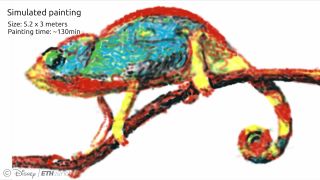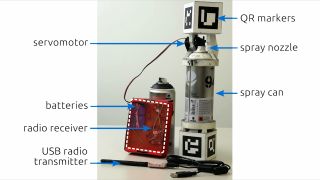
'Smart' Spray Cans Could Make Anyone a Mural Artist

Even someone who possesses no painting skills whatsoever could create a giant, wall-size mural with a bit of robotic assistance, using a system of "smart" spray cans.
A team of researchers has designed a prototype for a robotic, computer-assisted method that reproduces photographs as large-scale works of art, spray painting the results onto huge canvases (or building walls).
The system combines physical gestures and computer-controlled paint dispersal, with a picture rapidly emerging as the user waves a spray can in front of a surface. It produces a lower resolution version of the original that is still a remarkably accurate reproduction — even if the user didn't know what image he or she was painting. [In Photos: Art for Robots]
Tests were conducted on large sheets of paper, as the study authors encountered some difficulty in obtaining permission to unleash an army of computer-controlled graffiti artists on university buildings at Dartmouth College in New Hampshire, where the study took place.
An example shared by the researchers in a video showed a photograph of a boxer that was recreated as a mural measuring 5.6 feet by 3.9 feet (1.7 meters by 1.2 meters), and taking about 15 minutes to complete.

The researchers rigged a normal can of spray paint with a frame holding two cubes, one mounted at the top of the spray can and one at the bottom, which were decorated with quick response (QR) codes (a type of bar code that can be "read" by a camera to send information to a computer).
A motor that controlled the spray can's nozzle was wired to a small radio receiver, which received signals from a USB-powered transmitter connected to a nearby computer, the researchers said.
Sign up for the Live Science daily newsletter now
Get the world’s most fascinating discoveries delivered straight to your inbox.
Two webcams positioned to the user's left and right used the QR images to track the position of the spray can relative to the canvas, in real-time. As the user waved the spray can in front of the canvas, algorithms sent commands to the nozzle control, to dispense just the right amount of paint to reproduce that region of the picture.

On the computer screen, a "feedback" visualization showed the artist's progress on the picture, which helped the artist choose which area to paint next. The system even advised the artist when to change colors.
While the completed painting was somewhat lacking in fine details, the shape, shading and proportions were extremely faithful to the original photograph. The interactive system could allow unskilled users to enjoy the satisfaction of engaging in a physical act of creation, the researchers said, resulting in a painted image that they might not be able to execute unassisted.
"We hope that this work will inspire further interactive, creative applications of computer graphics in physical environments," the authors wrote in the study.
The findings were published online in the April issue of the journal Computer & Graphics.
Follow Mindy Weisberger on Twitter and Google+. Follow us @livescience, Facebook & Google+. Original article on Live Science.

Mindy Weisberger is an editor at Scholastic and a former Live Science channel editor and senior writer. She has reported on general science, covering climate change, paleontology, biology, and space. Mindy studied film at Columbia University; prior to Live Science she produced, wrote and directed media for the American Museum of Natural History in New York City. Her videos about dinosaurs, astrophysics, biodiversity and evolution appear in museums and science centers worldwide, earning awards such as the CINE Golden Eagle and the Communicator Award of Excellence. Her writing has also appeared in Scientific American, The Washington Post and How It Works Magazine.
Most Popular

